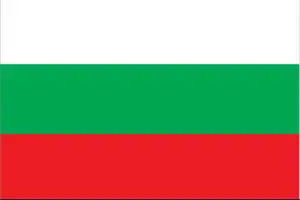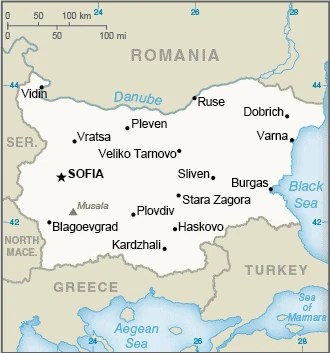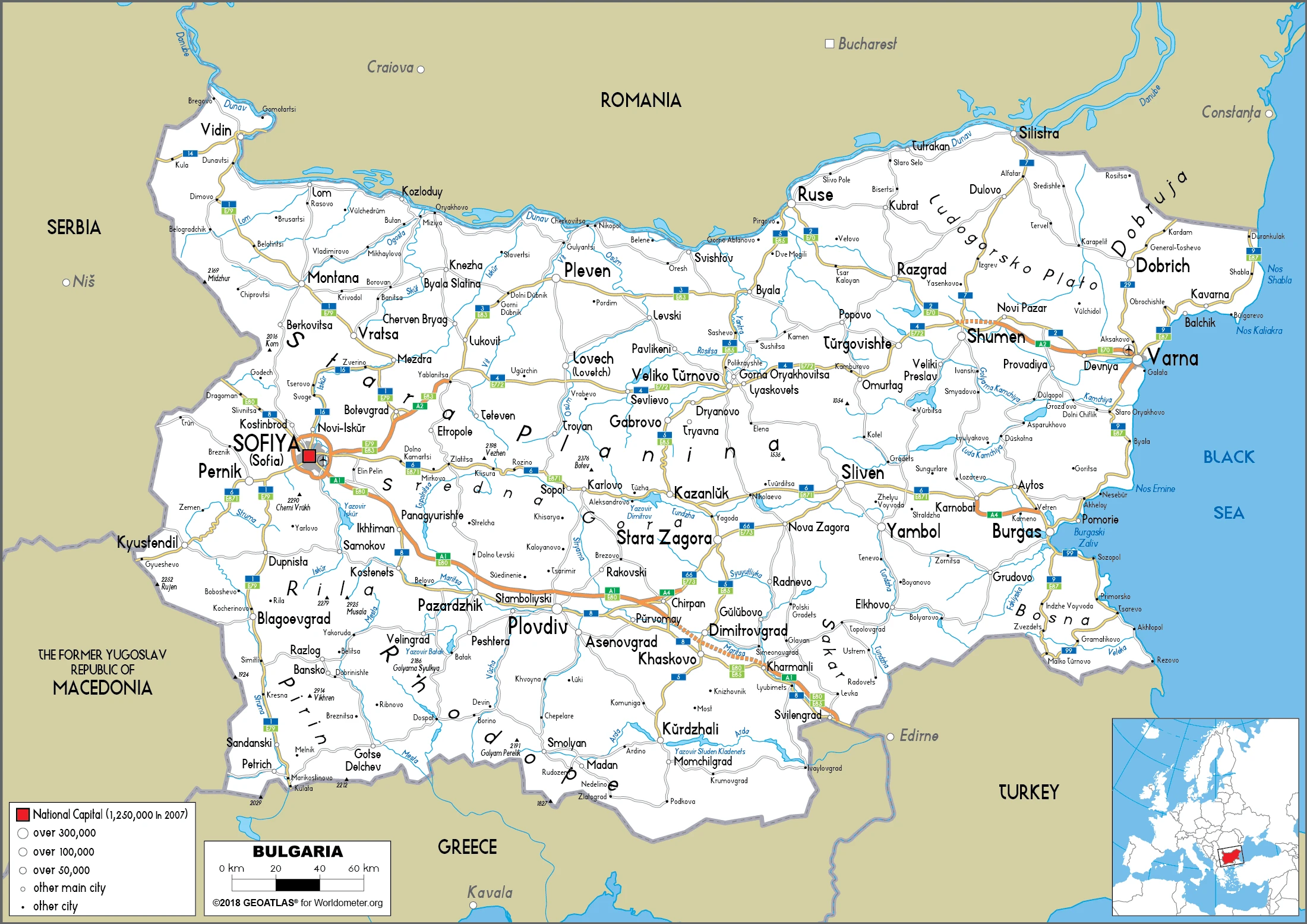Bulgaria Google Maps is a site/tool that offers a wide range of map views (topographic, satellite, street view) and navigation options, with little effort on your part, yet efficiently. If you need to plan a trip to a new place like Bulgaria, Google maps are available on desktop, mobile, or tablet. This Google maps and information page is dedicated to Bulgaria, Europe (47 countries), showing its location, country facts, details about its capital city Sofia, bordering countries like Greece, Macedonia, Romania, Serbia, Turkey, and plenty of other information which may be interesting when you visit this European state.
Quick links: Google Maps Bulgaria, Sofia Google maps, Driving Directions Bulgaria, Printable Road Map.
About Bulgaria in a nutshell

- Conventional short form of the name: Bulgaria
- The conventional long form of the name: Republic of Bulgaria
- Local long form: Republika Bulgaria
- Local short form: Bulgaria
- Former name(s): Kingdom of Bulgaria, Peoples Republic of Bulgaria
- Etymology: named after the Bulgar tribes who settled the lower Balkan region in the 7th century A.D..
- The legal system in Bulgaria: civil law.
- Climate: Hot summers, cooler at the coast. Snowy winters, especially in mountains. East winds bring seasonal extremes.
- The national symbols are lion; national colors: white, green, red.
- Internet TLD: .bg
Sandwiched between the Danube and the Rila-Rodopei Massif, the country’s topography is formed by the Balkan mountains, the Stara Planina. Bulgarian land, inhabited since ancient times, was conquered by Thracians, Greeks, Alexander the Great of Macedonia, and later by the Romans, and ravaged by Goths, Huns, and Avars. The Slavic ancestors of the modern Bulgarian people appeared in the region in the 7th century. Byzantine marks Bulgaria’s more recent history and then long Turkish rule, German and Russian influence, with several short periods of independence, the abolition of the monarchy, the republic, and, since 1989, the attempts at democracy. Bulgaria, which joined the EU on 1 January 2007, has two natural and seven cultural heritages as its universal treasures. The Pirin National Park is a habitat for indigenous species, while the Srebarna Reserve is a breeding ground for rare waterfowl.
The ancient city of Nesebar was a Thracian trading center in the 2nd millennium BC. The Thracian burial chamber of Kazanlak, built in the late 4th century BC, is part of a more important burial site. The richly decorated Thracian tomb found near Svestari is of similar date. The figure of the horseman of Madara, carved into a rock wall above the village of Madara, was a sacred site of the First Bulgarian Empire in the 8th century. The wall paintings in the rock churches of Ivanovo are masterpieces of medieval Bulgarian masters. The frescoes of the church of Boyana at the foot of the Vitosa Mountains represent the pinnacle of ecclesiastical painting from the 11th century. The monastery of Rila is the oldest and largest monastery in Bulgaria and was given its present form in the 19th century.
Archaeologists have found evidence of wine-making in Bulgaria dating back over 5000 years.
Background
The Bulgars, a Central Asian Turkic tribe, merged with the local Slavic inhabitants in the late 7th century to form the first Bulgarian state. Bulgaria struggled with the Byzantine Empire to assert its place in the Balkans in succeeding centuries. Still, by the end of the 14th century, the country was overrun by the Ottoman Turks.
Northern Bulgaria attained autonomy in 1878, and all of Bulgaria became independent from the Ottoman Empire in 1908. Having fought on the losing side in both World Wars, Bulgaria fell within the Soviet sphere of influence and became a Peoples Republic in 1946. Communist domination ended in 1990 when Bulgaria held its first multiparty election since World War II and began the contentious process of moving toward political democracy and a market economy while combating inflation, unemployment, corruption, and crime. The country joined NATO in 2004 and the EU in 2007.
Geography
Mountains run east-west across the center and along the southern border. Danube plain in the north, Thracian Plain in the southeast. The Black Sea to the east.

Located in southeastern Europe, Bulgaria was under communist rule from 1947 to 1989. Since then, significant political and economic reform enabled it to join the EU in 2007.
This state is located in Southeastern Europe, bordering the Black Sea, between Romania and Turkey, under the coordinates of 43 00 N, 25 00 E, covering an area of 110,879 sq km with a coastline of 354 km. Bulgaria is almost identical in size to Virginia, slightly larger than Tennessee.
Bulgaria has 1,806 km of land boundaries in total, and bordering with (5 nations): Greece 472 km, Macedonia 162 km, Romania 605 km, Serbia 344 km, Turkey 223 km.
Mostly mountains with lowlands in north and southeast, with Musala 2,925 m as the highest point of Bulgaria, while the Black Sea 0 m as the lowest point, causing a mean elevation at 472 m throughout the country. With a total of 110,879 sq km, Bulgaria has 108,489 sq km of land and 2,390 sq km water surface area.
The principal river is the Danube (shared with Germany, Austria, Slovakia, Czechia, Hungary, Croatia, Serbia, Ukraine, Moldova, and Romania) – 2,888 km. The significant watersheds for Bulgaria are Atlantic Ocean drainage: (Black Sea) Danube (795,656 sq km).
strategic location near Turkish Straits; controls key land routes from Europe to the Middle East and Asia
The climate in Bulgaria is as follows: Temperate, cold, damp winters, hot, dry summers.
When you visit Bulgaria, the natural hazards are Earthquakes and landslides.
The following major health-threatening issues shall be considered when visiting Bulgaria: none.
Current environmental issues affecting the Bulgarian people: air pollution from industrial emissions; rivers polluted from raw sewage, heavy metals, detergents; deforestation; forest damage from air pollution and resulting acid rain; soil contamination from heavy metals from metallurgical plants and industrial wastes.
Google Maps Bulgaria
The capital and other divisions
Capital city: Sofia found under the coordinates 42 41 N, 23 19 E, applying the time zone UTC+2 (7 hours ahead of Washington, DC, during Standard Time), using the following daylight saving time: +1hr, begins last Sunday in March; ends last Sunday in October.
Bulgaria’s capital and largest city, Sofia, is a beautiful place to visit. With its mix of old and new architecture, this European metropolis is one of the most exciting cities in Eastern Europe.
Bulgaria became independent on 3 March 1878 (as an autonomous principality within the Ottoman Empire); 22 September 1908 (complete independence from the Ottoman Empire), and its national holiday is Liberation Day, 3 March (1878).
Administrative divisions: 28 provinces (oblasti, singular – oblast); Blagoevgrad, Burgas, Dobrich, Gabrovo, Haskovo, Kardzhali, Kyustendil, Lovech, Montana, Pazardzhik, Pernik, Pleven, Plovdiv, Razgrad, Ruse, Shumen, Silistra, Sliven, Smolyan, Sofia, Sofia-Grad (Sofia City), Stara Zagora, Targovishte, Varna, Veliko Tarnovo, Vidin, Vratsa, Yambol.
People and society
The communists tried forcibly to suppress cultural identities; once the free movement was allowed in 1989, there was a significant exodus of Bulgarian Turks. Privatizations in the 1990s left many Turks landless, prompting further emigration. Roma suffers discrimination at all levels of society. Women have equal rights in theory, but society remains patriarchal. EU accession included caveats demanding further action against organized crime, human trafficking, and corruption.
The population in Bulgaria is 6,919,180 (July 2021 estimate), with an average of -0.67% (2021 estimate) change. That means Bulgaria is the No. 107 in the world’s populated rank list. With an average of 43.7 years median age (41.9 years for males and 41.9 years for women), Bulgaria ranks No. 20 on the globe’s median age rank list.
The people living in this country are the Bulgarian(s) (noun) or Bulgarian (adjective) and belong mainly to the following ethnic groups: Bulgarian 76.9%, Turkish 8%, Romani 4.4%, other 0.7% (including Russian, Armenian, and Vlach), other (unknown) 10% (2011 estimate). Note: Romani populations are usually underestimated in official statistics and may represent 911% of Bulgaria’s population.
They speak Bulgarian (official language) 76.8%, Turkish 8.2%, Romani 3.8%, other 0.7%, unspecified 10.5% (2011 estimate) languages and practice the following religions: Eastern Orthodox 59.4%, Muslim 7.8%, other (including Catholic, Protestant, Armenian Apostolic Orthodox, and Jewish) 1.7%, none 3.7%, unspecified 27.4% (2011 estimate).
We can conclude the following about the population in Bulgaria: A fairly even distribution throughout most of the country, with urban areas attracting larger populations. In Bulgaria, we are talking about 76% (2021) of the total population is living in cities, and most of them reside in the following municipalities: 1.284 million, Sofia (capital city) (2021).
Industry
Good agricultural production, including grapes, for the well-developed wine industry and tobacco. Expertise in software development. Industry and infrastructure are outdated.
Bulgaria, a former communist country that entered the EU in 2007, has an open economy that historically has demonstrated strong growth. Still, its per-capita income remains the lowest among EU members. Its reliance on energy imports and foreign export demand makes its growth sensitive to external market conditions.
The Government undertook significant structural economic reforms in the 1990s to move the economy from a centralized, planned economy to a more liberal, market-driven economy. These reforms included privatization of state-owned enterprises, liberalization of trade, and strengthening the tax system – changes that initially caused some economic hardships but later helped attract investment, spur growth and make gradual improvements to living conditions. From 2000 through 2008, Bulgaria maintained robust, average annual real GDP growth of over 6%, followed by a deep recession in 2009. The financial crisis caused domestic demand, exports, capital inflows, and industrial production to contract, prompting the Government to decrease spending. Real GDP growth remained slow – less than 2% annually – until 2015, when demand from EU countries for Bulgarian exports, plus an inflow of EU development funds, boosted growth to more than 3%. In recent years, strong domestic demand combined with low international energy prices have contributed to Bulgaria’s economic growth approaching 4% and helped ease inflation.
Bulgaria’s prudent public financial management contributed to budget surpluses in 2016 and 2017. Bulgaria is heavily reliant on energy imports from Russia, a potential vulnerability, and participates in EU-backed efforts to diversify regional natural gas supplies. In late 2016, the Bulgarian Government provided funding to Bulgaria’s National Electric Company to cover the $695 million compensation owed to Russian nuclear equipment manufacturer Atomstroyexport to cancel the Belene Nuclear Power Plant project Bulgarian Government terminated in 2012. As of early 2018, the Government was floating the possibility of resurrecting the Belene project. The natural gas market, dominated by state-owned Bulgargaz, is also almost entirely supplied by Russia.
Infrastructure projects such as the Inter-Connector Greece-Bulgaria and Inter-Connector Bulgaria-Serbia, which would enable Bulgaria to access non-Russian gas, have either stalled or made limited progress. In 2016, the Bulgarian Government established the State eGovernment Agency. This new agency is responsible for electronic governance, coordinating national policies with the EU, and strengthening cybersecurity. Despite a favorable investment regime, significant challenges remain, including low, flat corporate income taxes. Corruption in public administration, a weak judiciary, low productivity, lack of transparency in public procurements, and the presence of organized crime continue to hamper the country’s investment climate and economic prospects.
Bulgaria is rich in the following natural resources: Bauxite, copper, lead, zinc, coal, timber, arable land.
The main industrial sectors are electricity, gas, water, food, beverages, tobacco, machinery and equipment, automotive parts, base metals, chemical products, coke, refined petroleum, nuclear fuel, outsourcing centers.
The country’s export sectors are particularly strong in refined petroleum, packaged medicines, copper, wheat, electricity (2019), partnering with these nations: Germany 16%, Romania 8%, Italy 7%, Turkey 7%, Greece 6% (2019). The export trade resulted in $39.27 billion. Note: Data are in current year dollars (2020 estimate). In a global rank of the export, values resulted in Bulgaria’s position of 64.
Land use in Bulgaria: 36.7% (2018 estimate) forest, 16.4% (2018 estimate) other.
The arable land area is 29.9% (2018 estimate), and the agricultural land is 46.9% (2018 estimate). Land use for permanent crops 1.5% (2018 estimate), permanent pasture 15.5% (2018 estimate). The sum of the area of the irrigated land is 1,020 sq km (2012).
The main agro-industrial products of Bulgaria are wheat, maize, sunflower seed, milk, barley, rapeseed, potatoes, grapes, tomatoes, watermelons.
The country typically needs to import: crude petroleum, copper, cars, packaged medicines, refined petroleum (2019), partnering with the following nations: Germany 11%, Russia 9%, Italy 7%, Romania 7%, Turkey 7% (2019) in a sum value of $38.07 billion. Note: data are in current year dollars (2020 estimate) $41.84 billion. Note: data are in current year dollars (2019 estimate) $41.91 billion. Note: data are in current year dollars (2018 estimate). This sum value on the global ranking list of imports resulted in Bulgaria 65.
Bulgaria Driving Directions
In this post, you learned about Bulgaria, Southeastern Europe, bordering the Black Sea, between Romania and Turkey. We published some basic information about its capital Sofia, and the Bulgarian nation.
Are you interested in visiting Bulgaria and looking for driving directions? Click here to plan your route, or see a printable road map of Bulgaria below for an overview of the route network.
Printable map of Bulgaria
Did you know about Bulgaria?
You might know that the country’s name comes from a word that means “strong” or “masculine”.
The country is a member of the European Union and NATO. It has a rich history and culture that can be traced back to Thracian, Slavic, Byzantine, and Ottoman civilizations. Later on, the Russian Empire occupied the country until it became independent again.
After virtually visiting Bulgaria, you may also be interested in the neighboring countries: Greece, Macedonia, Romania, Serbia, Turkey.
If you liked our Google map and Bulgaria information page,
please share it with others or save the link https://www.drivingdirections.net in your bookmarks.

